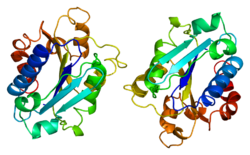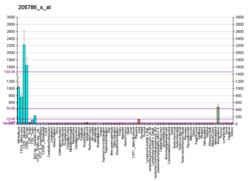Integrin alpha M (ITGAM) is one protein subunit that forms heterodimeric integrin alpha-M beta-2 (αMβ2) molecule, also known as macrophage-1 antigen (Mac-1) or complement receptor 3 (CR3).[5] ITGAM is also known as CR3A, and cluster of differentiation molecule 11B (CD11B). The second chain of αMβ2 is the common integrin β2 subunit known as CD18, and integrin αMβ2 thus belongs to the β2 subfamily (or leukocyte) integrins.[6]
αMβ2 is expressed on the surface of many leukocytes involved in the innate immune system, including monocytes, granulocytes, macrophages, and natural killer cells [5] and subsets of T and B cells.[7] It mediates inflammation by regulating leukocyte adhesion and migration and has been implicated in several immune processes such as phagocytosis, cell-mediated cytotoxicity, chemotaxis and cellular activation.[5] It is involved in the complement system due to its capacity to bind inactivated complement component 3b (iC3b).[8] The ITGAM (alpha) subunit of integrin αMβ2 is directly involved in causing the adhesion and spreading of cells but cannot mediate cellular migration without the presence of the β2 (CD18) subunit.[5]
In genomewide association studies, single nucleotide polymorphisms in ITGAM had the strongest association with systemic lupus erythematosus, with an odds ratio of 1.65 for the T allele of rs9888739 and lupus.[9][10]
In histopathology, immunohistochemistry with antibodies against CD11B is frequently used to identify macrophages and microglia.
- ^ a b c GRCh38: Ensembl release 89: ENSG00000169896 – Ensembl, May 2017
- ^ a b c GRCm38: Ensembl release 89: ENSMUSG00000030786 – Ensembl, May 2017
- ^ "Human PubMed Reference:". National Center for Biotechnology Information, U.S. National Library of Medicine.
- ^ "Mouse PubMed Reference:". National Center for Biotechnology Information, U.S. National Library of Medicine.
- ^ a b c d Solovjov DA, Pluskota E, Plow EF (January 2005). "Distinct roles for the alpha and beta subunits in the functions of integrin alphaMbeta2". The Journal of Biological Chemistry. 280 (2): 1336–1345. doi:10.1074/jbc.M406968200. PMID 15485828.
- ^ Larson RS, Springer TA (April 1990). "Structure and function of leukocyte integrins". Immunological Reviews. 114: 181–217. doi:10.1111/j.1600-065X.1990.tb00565.x. PMID 2196220. S2CID 36709941.
- ^ Khan SQ, Khan I, Gupta V (2018-03-15). "CD11b Activity Modulates Pathogenesis of Lupus Nephritis". Frontiers in Medicine. 5: 52. doi:10.3389/fmed.2018.00052. PMC 5862812. PMID 29600248.
- ^ Arnaout MA, Todd RF, Dana N, Melamed J, Schlossman SF, Colten HR (July 1983). "Inhibition of phagocytosis of complement C3- or immunoglobulin G-coated particles and of C3bi binding by monoclonal antibodies to a monocyte-granulocyte membrane glycoprotein (Mol)". The Journal of Clinical Investigation. 72 (1): 171–179. doi:10.1172/JCI110955. PMC 1129172. PMID 6874946.
- ^ Crow MK (February 2008). "Collaboration, genetic associations, and lupus erythematosus". The New England Journal of Medicine. 358 (9): 956–961. doi:10.1056/NEJMe0800096. PMID 18204099.
- ^ Hom G, Graham RR, Modrek B, Taylor KE, Ortmann W, Garnier S, et al. (February 2008). "Association of systemic lupus erythematosus with C8orf13-BLK and ITGAM-ITGAX". The New England Journal of Medicine. 358 (9): 900–909. doi:10.1056/NEJMoa0707865. PMID 18204098.





